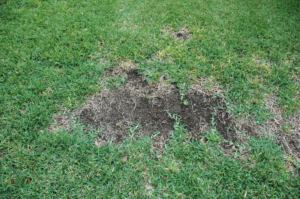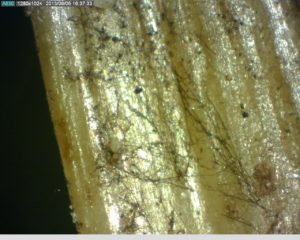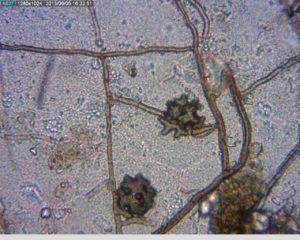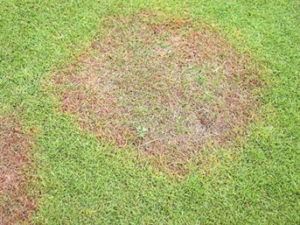Written by Taylor Duke — TPDDL Student Worker;
Edited by Hannah Ayala — Extension Assistant
If you’ve been noticing brown patches in your lawn lately, it’s most likely infected by the pathogen commonly known as Take All Patch. Take All Patch is caused by the soil-borne fungus Gaeumannomyces graminis var. graminis, or as we like to call it here in the lab, “Ggg”. The season of Ggg is upon us and we have been receiving lots of grass samples in the lab that are positive for this pesky fungus. Ggg could be considered the arch-nemesis of homeowners and golf course managers alike. It attacks the root systems of St. Augustinegrass and bermudagrass, and causes dead patches in the turf that may continue to grow if uncontrolled. Ggg thrives in moist climates with moderate temperatures, and is most active during the fall, winter, and spring (Duble). All of the rain we’ve been getting lately has created the perfect breeding grounds for the fungus.
The first visible symptoms of Ggg are yellowing and wilting of leaf blades in circular or irregular patterns and darkening of the roots (“Take all Patch”). As the disease progresses, the grass thins and the patches become bare as the plants die. These patches can be anywhere from one to twenty feet in diameter. Due to thinning of the roots, the stolons of seriously infected turf can easily be pulled up from the ground. Ggg is often mistaken for another disease known as brown patch, but the leaves of Ggg infected grass cannot be easily separated from the plant (Duble). Under a dissecting microscope, you can see the dark strands of Ggg’s runner hyphae along the roots and stolons. Using a compound microscope, Ggg is easily identified by its dark, flower-like infection structures known as hyphopodia (Vann).
Ggg overwinters as mycelium on both living and dead infected plant material (“Take all Patch”). When climate conditions are cool and moist, during the fall, the fungus will grow along the surface of the plant then penetrate and infect the root system. Symptoms become more evident around summertime as the hot, dry weather stresses the host plants. Ggg is transported mechanically on lawn mowers and other equipment that pick up pieces of infected plant tissue.
How can you help prevent your lawn from developing unsightly dead patches? Unfortunately, there are no varieties of St. Augustine or Bermuda that can resist Ggg infection. So, control of this pathogen focuses on cultural and chemical practices. For starters, avoid thatch buildup as it can easily spread the disease across an entire lawn. Make sure you are properly fertilizing to keep your turf healthy and strong. Fungicides, if you choose to use them, should be applied in the early fall as a preventative measure (Vann). Finally, the most important thing you can do to avoid a breakout of Take All Patch is PROPERLY IRRIGATE! Make sure that your soil has good drainage and don’t over water your lawn. Too much water creates the perfect environment for Ggg to grow. The best practice is to water infrequently and deeply only when the grass needs it (“Take all Patch”).
References
Duble, Richard L. “Take-All Patch (Bermuda Decline).” Aggie Horticulture, Texas A&M AgriLife Extension Service, aggie-horticulture.tamu.edu/archives/parsons/turf/publications/takeall.html.
“Take All Patch.” Real Green, Real Green Pest and Lawn Care, 2010, www.realgreenlawns.com/austin_tx_texas/takeallpatch.htm.
Vann, Stephen, and Terry Spurlock. Take-All Root Rot of Warm-Season Turf. Take-All Root Rot of Warm-Season Turf, University of Arkansas Division of Agriculture Research and Extension.
Want to learn more?
WHAT Wednesday turfgrass series







